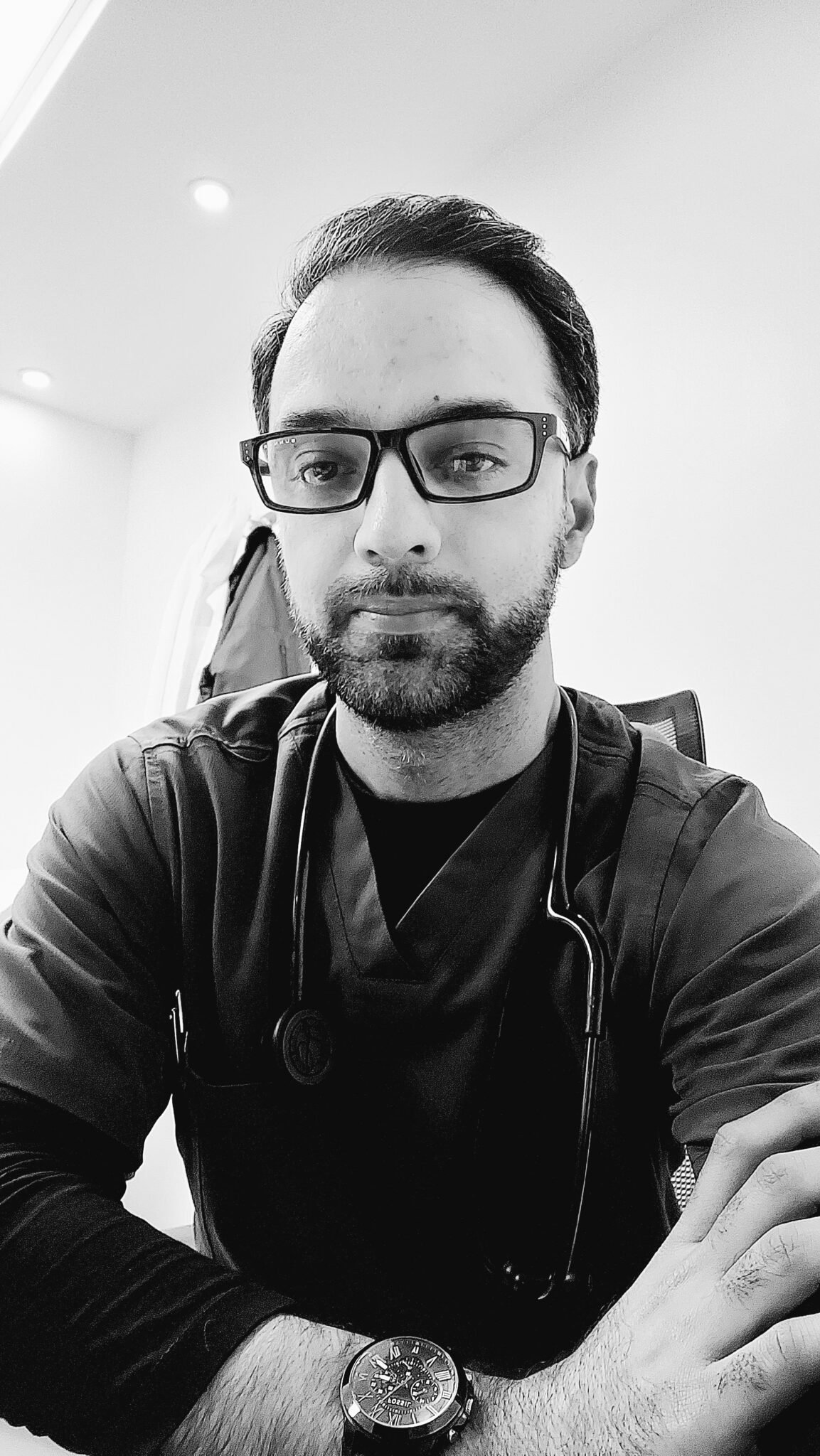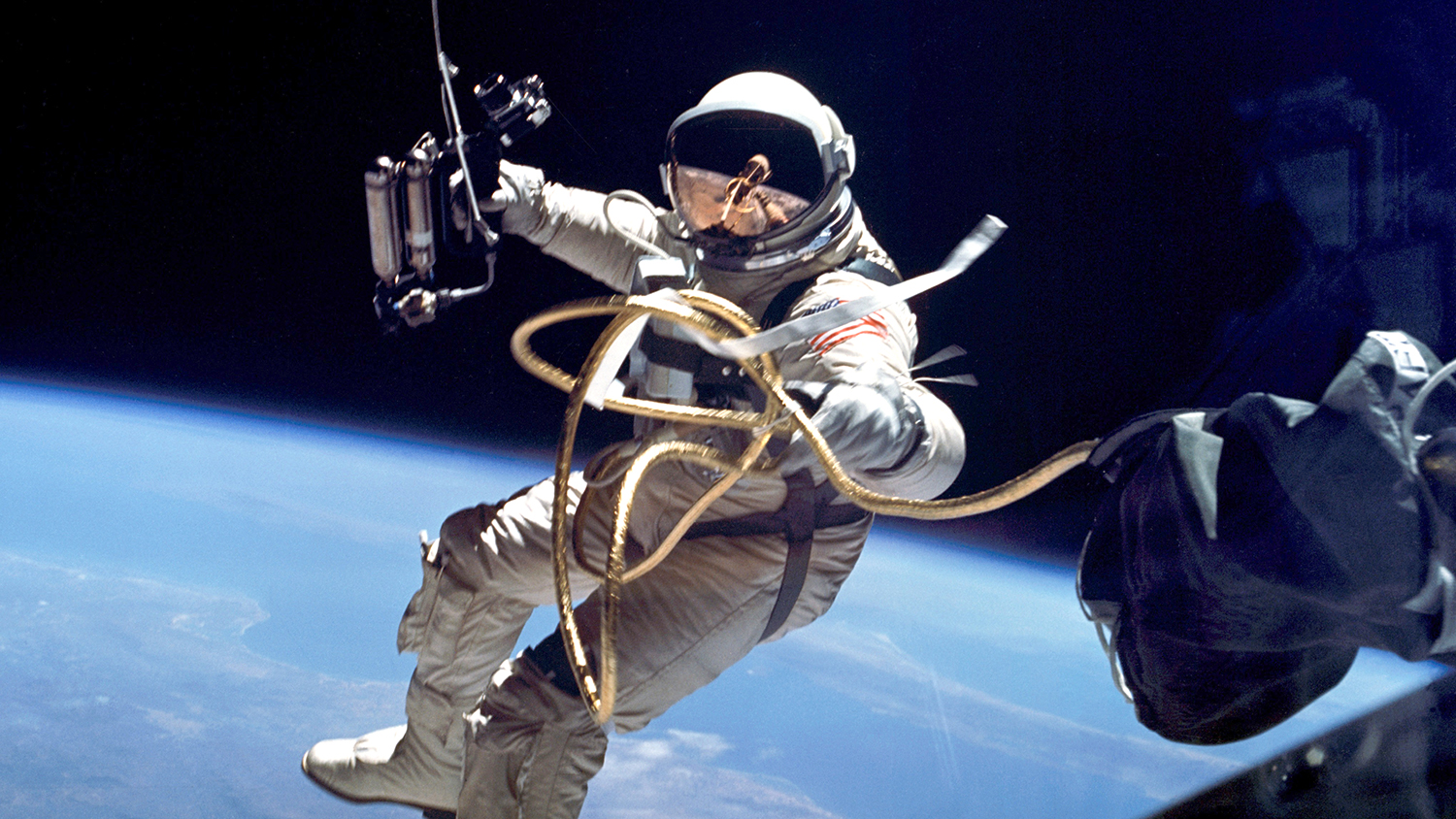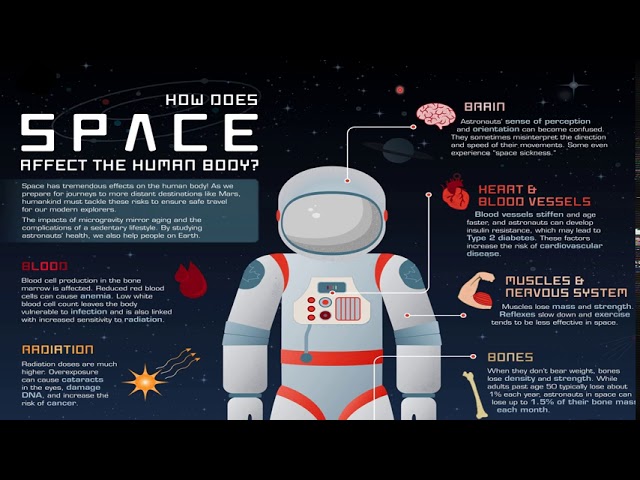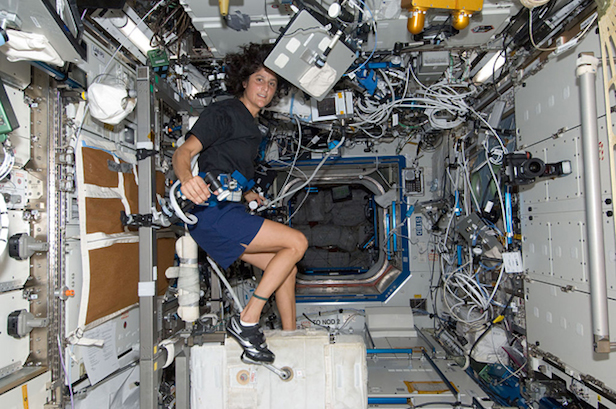The vastness of space charms everyone and many of us probably dreamed of becoming astronauts at one or many points in our lives. Such is the fascination of that which lies beyond our beloved earth. But little do many people realize that being an astronaut is probably the toughest job in the world or should we say ‘The Universe’. Only the toughest of the toughest both in terms of physical and mental aspects are selected. Being fit and skilled enough to go into space is just the beginning since the actual test of the human body and brain begins thereafter since space is vast, cold, harsh, and inhospitable.
This piece will cover the challenges faced by the human body in space and what lies ahead for us.
EFFECTS ON THE HUMAN BODY
- FROM EXTREME GRAVITATIONAL FORCE TO ZERO GRAVITY
When humans leave the earth in capsules/shuttles piggybacking on rockets they are exposed to extreme gravitational energy of the earth since the energy is equivalent to the energy with which the rockets are blasting upwards through our atmosphere. The bodies of the astronauts are subjected to these ‘G’ forces which can even cause unconsciousness/blackouts.
Once in space, the lack of gravity is what they are exposed to in their space vehicle or the space station where they dock. This zero ‘G’ can have varied effects on the human body, we are used to earth’s gravitational pull ever since we are born. Astronauts can experience nausea, light-headedness, and disorientation to which they get used to overtime. The same ‘G’ forces plus the heat are also experienced by astronauts when they re-enter in earth’s atmosphere.
2. CHANGE IN MUSCLE AND BONE PHYSIOLOGY
Weightlessness has effects on human bones and muscles. Since the body needs to sense pressure and weight-bearing on muscles and bones in order to maintain normal strength and composition. In the absence of gravity, the body senses no weight bearing on the bones, muscles, and joints.
As a result, it considers them not necessary to maintain in terms of nutrition and growth. Thus, the muscles, bones, and joints start to waste. There the calcium is taken up the bones, muscles grow thin and the high calcium and other chemicals in the blood can result in other consequences as well. To counter this, astronauts on the International Space Station ( ISS) undergo regular fitness sessions where they work out on machines that ‘tie them down’ in zero gravity so that they can work out.
3. EFFECTS ON SLEEP
Astronauts on the ISS as it is in continuous low orbit around the earth experience 16 sunrises and sunsets during 24 hours. This may sound fascinating to see but it greatly interferes with the sleep mechanisms of the body. Since our brains & bodies are tuned to the gradual fading of sunlight and release of the ‘melatonin’ hormone which facilitates sleep, the many sunrises and sunsets astronauts experience impairs the whole process.
Plus, the extreme noise aboard the station doesn’t help either. How do they counter this? They follow the Greenwich meantime as a time zone for day and night and are allocated 6-8 hours of sleep per day. They sleep in sleep-cabins the size of telephone booths mostly vertically, weightless (yes vertically!), and use earplugs and eyeshades. Sleeping does prove to be challenging in space.
4. EFFECTS OF RADIATION
This is by far the most important health hazard faced by astronauts. Skipping the technical stuff, cutting long story short, radiation in space is composed of highly charged particles that can run through matter unhindered. Examples are X rays, Gamma rays, Galactic cosmic rays. The sources are stars, quasars, and also our sun (solar flares especially). These are called IONIZING since they basically just run through matter and change the atomic structure of matter. This is what our bodies experience when getting an XRAY or CT scan imaging done.
Obviously, we don’t actually feel anything physically in space and our atomic/molecular structure does get disturbed when exposed to such high-energy particles. Imagine being exposed to 100s and even thousands of X rays during stay aboard the ISS. This can cause acute radiation sickness much like which can happen in cancer patients who get radiation therapy. Symptoms include vomiting, diarrhea, hair loss, and skin changes. Long exposures can lead to increased risk of developing cancers, brain degeneration diseases, damage to the heart and blood vessels and the list goes on.
5. PSYCHOLOGICAL EFFECTS
Space is lonely especially since the astronauts are confined to small spaces with people who they have to get along in functional terms for months. It takes a heavy toll on a person’s mind living in such an environment on earth let alone in the emptiness of space. Astronauts are trained beforehand for such a situation while on earth and are adept at handling tough mental conditions.
Working in coordination with colleagues putting aside any differences while at the same time having the thoughts of loved ones at home. Put this on repeat for months or even years when humankind ventures farther into space. It may put a heavy toll on mental health.
6. EFFECTS ON THE BRAIN, VISION & OTHER SENSES
Space flight and its hazards especially radiation may lead to damage to the areas of the brain which are concerned with memory, both old and new. It has been observed in studies that astronauts who travel to space develop structural changes in the brain as seen by MRI. The changes are proportionate to the number of visits to outer space. Astronauts develop problems with the balance due to disturbances in the balance organs of the internal ear. They also report changes in taste while being on space missions. Vision is a sense of ours that is prone to be lost especially during future long-duration missions in space (as MARS missions).
Due to zero Gravity and reduced blood supply to the eye during space travel, the eye as an organ may start to reduce the perception, and eventually, vision may diminish leading to blindness. This is a serious risk that astronauts may face. However, all is not bleak. A study conducted in 2020 showed that a few Russian astronauts who spent time on the ISS had developed new motor skills and correspondingly changes in the structure of the brain. Showing that the brain has the ability to adapt to the alien environment of space and its habitat1.
ASTRONAUT EXPERIENCES
Up till Jan 2022, almost 600 astronauts from 41 different countries have been in space. With their duration of space varying. The longest individual duration in space is logged by Valeri V. Polyakov, a Russian who spent 437 days in space on the SOYUZ missions in 1994. The longest total duration logged by an astronaut is 878 days, by Russian Gennadi Padalka from 1998 to 2015 in different missions.
A Tragedy struck the SOYUZ 11 mission to the Russian space station SALYUT-1 ( first space station in earth orbit ) in 1971. When three Astronauts ( Cosmonauts as the Russians call them) Georgi Dobrovolski, Vladislav Volkov, and Viktor Patsayev died during the return trip to earth. The capsule returned to earth but when the hatch was opened, they were found dead and the cause of death was ascertained to be suffocation due to a faulty seal in the capsule leading to rapid decompression.
A survey by NASA on 300 male and female astronauts showed that 49 % of long flight astronauts had near and distant vision problems during the missions. Some even admitted to the problems persisting for years afterwards2. Considering the exposure to high doses of ionizing radiation in space it is predicted that astronauts will be suffering from effects when they return.
However, recent studies show quite surprisingly no relation with the doses of radiation to which astronauts were exposed and proposed cancer and cardiovascular deaths3. This probably has to do with the increasingly fit physical condition of the astronauts are in and the aggressive health surveillance for these they undergo. Space vehicles and space suits with increased protection against ionizing radiation (dampening them though not elimination risk) probably reduce the exposure.
Diagnostic techniques will probably be needed which will detect DNA damage in response to radiation and interventions done immediately with nanobots. These bots will detect the damage and instantaneously correct the defects.
The same cannot be said when we will embark on long-duration missions like one to Mars where the low dose exposure for a longer duration may lead to health complications. Studies conducted on astronauts who had been to the moon (APOLLO missions) concluded that they were dying mostly of cardiovascular diseases.
Although the deaths from cardiovascular mortality were higher in lunar astronauts, the sample size was small and there was no ‘statistical difference’ from the general population but considering that astronauts are in peak physical condition this may be alarming and pointing to radiation & weightlessness probably being contributive towards developing serious health conditions.
Space exploration now entering an exciting new era now after so many satellite missions now deployed in and beyond our solar system (Voyager 2). We will eventually have to ensure that humans can travel across long distances in space with as little harm as possible to their bodies. The following could be ways forward.
ARTIFICIAL GRAVITY AND SHIELDING
Using the principle of centripetal force any space structure when revolving around its axis can generate artificial gravity and this may be extremely useful in dampening the effect of zero-G on humans. Gravity on earth certainly has profound effects on our lives than just giving us solid footing on earth.
Since we as species are in tune with the gravitational force of the earth, being without its influence especially when traveling across larger distances (take for example to Mars for starters) may be harmful to us any countless ways. Which probably we will find out when we finally set sail for planets beyond the moon. Gravitational field generators on space crafts will be another alternative to provide the necessary attractive force.
Radiation exposure as previously mentioned is probably inevitable in space. Though the exposure can be minimized by an appropriate lining of the space crafts (lead is used for shielding). The harmful effects of ionizing radiation may be reduced but the hazard cannot be eliminated.
And how much exposure will cause disease and harm is yet to be known when we travel long distances. Individual genetic variations may exist as to how much radiation may result in effects in different individuals. This will need extensive research when our interplanetary exploration commences.
NANOTECH AND FURTHER ADVANCES
Space travel across long-distance is and may not be as simple as is shown in science fiction. Such travel will need humans to be resistant to the harsh environment of space. Humans will need to be ‘upgraded’ probably by genetically enhancing our genetic makeup to face radiation poisoning, to reduce our need for sleep, and perform efficiently during the long haul.
Astronauts would probably be genetically tweaked to lose the stress and fear response so that they would remain calm. During space travel, medical teams with expertise in highly advanced medicine will need to be on board to make sure that medical issues are taken care of. Diagnostic techniques will probably be needed which will detect DNA damage in response to radiation and interventions done immediately with nanobots. These bots will detect the damage and instantaneously correct the defects.
Stem cell procedures would have to be developed and polished before embarking on long space travel. So that when the need arises to deal with organ failure/cancer diagnosis, stem cell techniques would regenerate tissues/organs during space flight.
Finally, cryogenic sleep is one highly stylized and fictionalized concept in modern film and Sci-Fic literature. We might eventually need it to put whole crews into hibernation during long-distance travels in our solar system initially and then maybe even beyond!
Bibliography
- Jillings, S., et al. (2020). “Macro- and microstructural changes in cosmonauts’ brains after long-duration spaceflight.” 6(36): eaaz9488.
- “NASA Finds that Space Flight Impacts Astronauts’ Eyes and Vision”. American Academy of Ophthalmology. 2013-07-10.
- Elgart, S.R., Little, M.P., Chappell, L.J. et al. Radiation Exposure and Mortality from Cardiovascular Disease and Cancer in Early NASA Astronauts. Sci Rep 8, 8480 (2018).
- Delp, M., Charvat, J., Limoli, C. et al. Apollo Lunar Astronauts Show Higher Cardiovascular Disease Mortality: Possible Deep Space Radiation Effects on the Vascular Endothelium. Sci Rep6, 29901 (2016).
Also, Read: Astronaut Scot Kelly’s stellar year in the outer space

Dr Syed Hunain Riaz is a Physician with expertise and experience in Endocrinology & Metabolism with a passion for eliciting change through the dissemination and application of precise knowledge. He is a space enthusiast, avid reader, blog writer, amateur photographer ( Astro & every day), and gamer.
Writing interests include preventive & lifestyle medicine and psychosocial issues. Dr. Hunain believes in limitless creativity and productivity of the human mind. Nature of consciousness, reality, and patterns in the universe are areas of special interest. He can be reached at syedhunain@gmail.com



